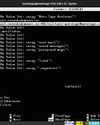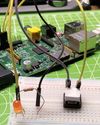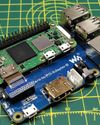ANALOG ZERO: Get to grips with analog electronic control
Linux Format
|September 2022
Les Pounder "cranks that dial" to relive his youth of soldering irons and 1980s electronics, when a 'bit' was a relatively unknown concept.

OUR EXPERT Les Pounder is associate editor at Tom's Hardware and a freelance maker for hire. He blogs about his adventures and projects at bigl.es.
YOU NEED
> Any model of Raspberry Pi
> Raspberry Pi OS
> RasPIO Analog Zero
> A breadboard
> An LED
> 10K Ohm
> 330 Ohm resistor (orange-orange-orange-gold)
> 3x F2M jumper wires
> 1x M2M jumper wire
> Code https://github.com/ lesp/LXF-Analog-Zero/ archive/refs/heads/main.zip potentiometer
Electronics are all digital, right? Nope - some electronics components work with analog signals. These signals are continuously running and are typically a variable voltage. Such components include thermistors (a variable resistor whose resistance varies depending on temperature) and photosensors (a variable resistor whose resistance changes depending on light levels).
The most common analog electronic component is the potentiometer. This is a variable resistor that changes resistance based on the user turning a knob. A common potentiometer has a value of 10 Kiloohm (10K) and it can be found in many electronics kits. However, you can't directly wire a potentiometer to a Raspberry Pi. The Pi's GPIO has many pins for digital electronics (and protocols such as 12C, SPI, PWM and 12S), but none of the GPIO pins can be used with analog electronic components. Digital GPIO pins have two states: on and off. Analog components have a variable signal, which could cause issues. So how do we use analog components with a Raspberry Pi? For that we need an ADC, an Analog to Digital Converter.
Esta historia es de la edición September 2022 de Linux Format.
Suscríbete a Magzter GOLD para acceder a miles de historias premium seleccionadas y a más de 9000 revistas y periódicos.
¿Ya eres suscriptor? Iniciar sesión
MÁS HISTORIAS DE Linux Format

Linux Format
Create your first WebSocket service
Mihalis Tsoukalos explains how to use the Go programming language to work with the WebSocket protocol.
9 mins
April 2023

Linux Format
Fantastic Mr Firefox
Nick Peers takes a trip down memory lane to reveal the story behind the rise - and slight fall - of Mozilla's popular web browser.
9 mins
April 2023

Linux Format
Set up your terminal and email like it's 1983
Jump in the hot terminal time machine with Mats Tage Axelsson who emails from the command line using the latest technology.
8 mins
April 2023

Linux Format
Universal layer text effects with GIMP
Posters use them, films and presentations are hard to imagine without them: text effects. Attract attention with Karsten Günther and GIMP.
8 mins
April 2023

Linux Format
Jump to a federated social network
Nick Peers reveals how you can get up and running with this free, decentralised and non-profit alternative to Twitter.
9 mins
April 2023

Linux Format
Free our SOFTWARE!
Taking anything for granted is dangerous, so Jonni Bidwell and Mike Saunders revisit how the free software movement got started to help free us from proprietary tyranny!
4 mins
April 2023

Linux Format
Master RPI.GPIO
Les Pounder goes back to the early days of the Raspberry Pi - and his career with this classic library! -
5 mins
April 2023

Linux Format
Waveshare Zero to Pi3
Transform your Pi Zero into a Pi 3, they promised Les Pounder, but it's more like adding on go-faster stripes.
2 mins
April 2023

Linux Format
The Best OPEN SOURCE Software Ever!
In an attempt to trigger controversy, Michael Reed and Neil Mohr unequivocally state these are the greatest free software apps ever. Probably. We’re just trying to be helpful.
19 mins
April 2023

Linux Format
Linux-Mandrake 7
Simplicity and a wide range of applications make this a great distribution for all Linux users.
2 mins
April 2023
Translate
Change font size

